The main traveler is one of those love-hate pieces of gear on a boat. We love that it separates control of twist and angle of attack into a quick and instinctive process. We hate it when it clutters up a cockpit and fear it when it slashes across the deck during a breezy weather jibe. A traditional alternative is a split- or twin-mainsheet system. We thought this setup had become extinct, but in fact we’re seeing it on a few of today’s high-performance multihulls, which suggests it still has merit. Every user we interviewed loved it. And so some testing was in order.
There are three main arguments in favor of a split mainsheet.
- Convenience. The traveler track is in the way. Often a twin mainsheet system can be designed to span a cockpit or cabin.
- Simplicity. Travelers are expensive, wear over time, and occasionally fail spectacularly.
- Better jibe control. Because the two lines create a triangle, the boom can be fully controlled through the jibe. Countless MOBs and notable fatalities have resulted from accidental jibes, (see “Risk Management and Renting Adventure,” PS January 2017).
Even if you have no interest in converting your system or buying a boat with twin mainsheets, it can be a robust jury rig that every cruising sailor should understand. As long as you have a pair of unused winches, a twin-sheet system can be rigged from gear on hand in a matter of minutes.
How We Tested
It was a simple matter to rig our test boat for both traveler sheeting and twin-tackle sheeting. We don’t use our secondary winches under working sail, so we installed a pair of turning blocks where the rail of a monohull would be and set up a simple 2:1 block and tackle led to winches. We equipped both systems with a quick connect at the boom end so that we could easily switch back and forth between sheeting systems.
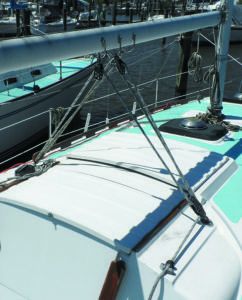
Observations
Retraining is required. Instead of adjusting the twist with the sheet and angle of attack with the traveler, the adjustments are combined. When sailing to windward the sheets are each about the same length, both highly loaded and most adjustments require pulling two strings. When the leeward sheet is trimmed, the leach closes and the boom moves to leeward. If the windward sheet is trimmed, the leach closes and the boom moves to windward. Perfecting boom position and twist requires adjusting both in a trial and error process. Dumping a sheet in a gust increases twist, but not as quickly or dramatically as releasing a single sheet. You can’t play the traveler in a breeze, the way many racers do, varying the angle of attack without increasing twist.
Marking the sheets at the centered, windward position can be handy during the learning phase. Mark both the low-tension setting, used during jibes and when the main is furled, and the fully loaded windward position. This will reduce trial and error.
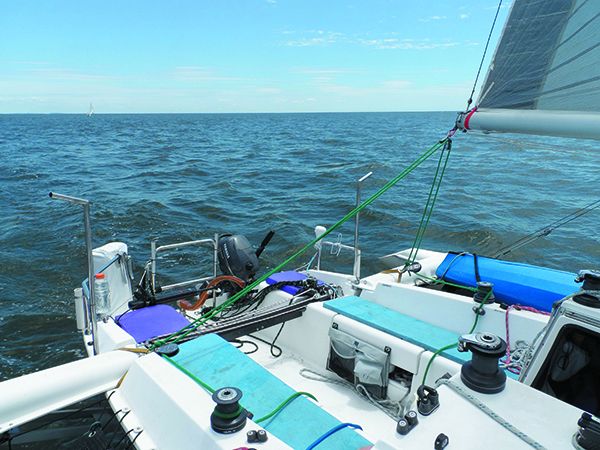
Like many running rigging modifications, switching to a twin-mainsheet arrangement has advantages and disadvantages. One of the most rewarding benefits has been the ability to prevent unnecessary movement of the boom.
Pros
- Jibing. Better control and less traveler hazard in heavy air.
- Boom does not bounce around as much in lumpy conditions.
- No vang. (Actually, the need for a vang is about equal in both systems.)
- May better accommodate cabins and dodgers.
- Better stabilizes boom at anchor, but may block cockpit.
- From 5 to 35 percent less sheet purchase is required, depending on the width of the sheeting base. (Typically, a dual-sheet system offers little or no advantage for multihulls.)
- Cheaper. However good block and tackle setups still aren’t cheap.
Cons
- Jibing. More trimming in light to moderate conditions.
- Sail can back and fill violently in certain conditions, since the boom cannot move.
- More complex sheeting. Unlike traveler systems, twist and angle of attack are not separate adjustments.
- More weight on the boom.
- Tackle can block cockpit when reaching.
- Nearly double sheet length. Tripping and entanglement hazard.
- More expensive if you need two additional winches. Slightly cheaper if tackles will work, though a pair of good tackles still aren’t cheap.
There is a lot to like about twin sheets when jibing in a breeze. First, pull in the leeward sheet to the center position mark. Then pull the windward sheet to same length, centering the boom and securing it. Once through the eye, release the new windward sheet followed by easing the leeward sheet as needed. The process is very smooth and the boom is fully controlled throughout the jib. The boom will lift a little more than with a traveler, but not excessively so.
Using a traveler, you first sheet the main in fairly tight, then center the traveler or even bring it a bit to windward. The boom will thump a short distance when the wind moves from one side to the other, but only a little if the mainsheet was snug, after which the traveler is eased all the way down, followed by the easing the sheet as required. If the sheeting base of the twin mainsheet system is the same as the traveler length (both should be as wide as practical) the amount of mainsheet out during the jibe is the same in both cases.
When jibing in light winds, the advantage is goes to the traveler system, which can be left to run free. In moderate winds jibing safety and ease
becomes roughly equal, with the edge on trimming speed going to the traveler, and often, the edge on trimming range, to the twin sheet system.
Some say twin sheets work like a vang. Well no, not really, no more than a traveler system does. Most multihulls dispense with a vang entirely for this reason; a full width traveler provides sufficient twist control. Neither functions exactly like a vang. However, using a vang with twin mainsheets is a bit like scratching your head and patting your tummy at the same time. We found it hard to keep straight and would avoid it. With a traveler system, it is simple to switch between vang sheeting and traveler sheeting, and they can even be combined without complication.
A single continuous sheet was simpler to manage with twin sheets. It saves some length, since the leeward tackle is always shorter than windward tackle. It also reduces tangling, because there is no free end to form knots. You can always bring both ends to the windward rail. It does leave a lot of line on the floor. Remember the old saying, “Mainsheet men hop on one leg?” You’ll need to watch your footing and learn some boat-specific line management.
No traveler equals less cockpit clutter. Yes, a traveller divides the cockpit in two. But the twin-sheets interfere in a similar way. We really dislike the mid-cockpit traveler on the F-24. If you want to go aft you have to step over it; with twin sheet systems through-transom access is clear. But with the twin mainsheet system, we had to duck under the windward sheet, especially when off the wind, a time when the cockpit is normally free.
The same argument can be made for securing the boom at anchor. On one hand this is dead easy with two sheets. On the other hand, even if you secure it off to one side, one of the sheets still crossed the cockpit. On our PDQ we would often move the traveler to one side to clear the aft cockpit walk-trough and secure the boom with a short line to a cleat, creating the same sort of triangle. The overall advantage or disadvantage is boat specific.
A common argument for twin sheets is safety since the most powerful sail on the boat is also the most dangerous, but a traveler used correctly is just as safe.
- A boom brake can help control a jibe, but it is not the same as having a mainsheet that will set and hold.
- For testing twin sheets we attached the sheet leads to the trimaran’s beams using a strap with D-rings at each end.
- When reaching the two sheets combine to help control the height of the boom above the deck.
- The twin-sheet arrangement on the Corsair F-24 test boat can be swapped for a conventional mainsheet quickly for comparison.
In addition to the twin-sheet arrangement described in the adjacent article, Practical Sailor has looked at various techniques to trim and tame the mainsail. Many of the measures are relatively inexpensive and are simple to carry out.
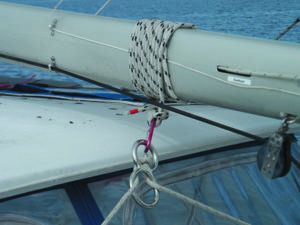
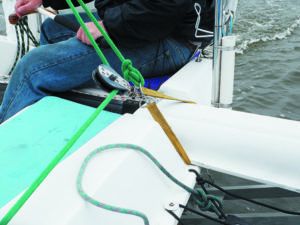
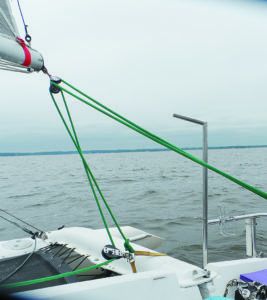
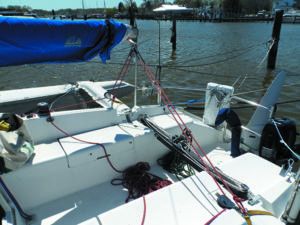
Some related reports include:
“The Multifarious Mainsheet” PS May 2013.
“Tools to Tame the Jibe” PS July 2017.
“Testers Examine Running Rigging Options,” PS November 2010.
“Undoing Mainsheet Twist.” PS February 2018.
“Taming the Main: Sail-Handling Systems for Bigger Mainsails,” February 2008.
Safety
There is no traveler car potentially zipping from side to side. On the other hand, the extra rope poses a tripping and entanglement hazard. Both can be managed.
We’ve heard it said a twin sheet system can serve as a preventer of sorts, because if the sheet is kept short, the boom cannot fly across the cockpit center line.
We reject this as an advantage, because exactly the same can be said of a properly used traveler. With the traveler locked down at the end of its travel, and with each sheet in a dual-sheet system kept the same length, the swing of the boom is the same.
However, if you run downwind with the traveler centered, the boom held down with the vang, and a lot of sheet out, or you do not lock the traveler car down at the end, the boom can move violently, but only because you are not using the equipment correctly.
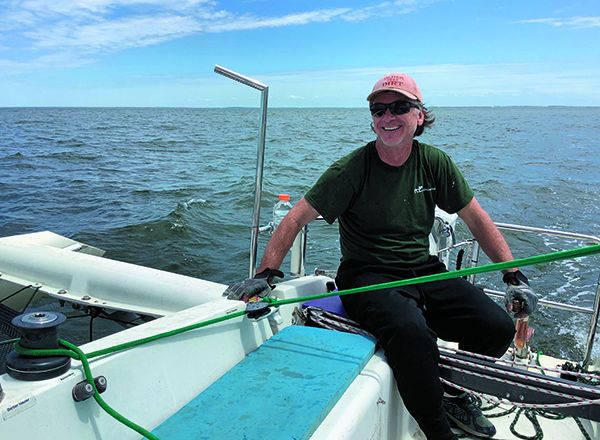
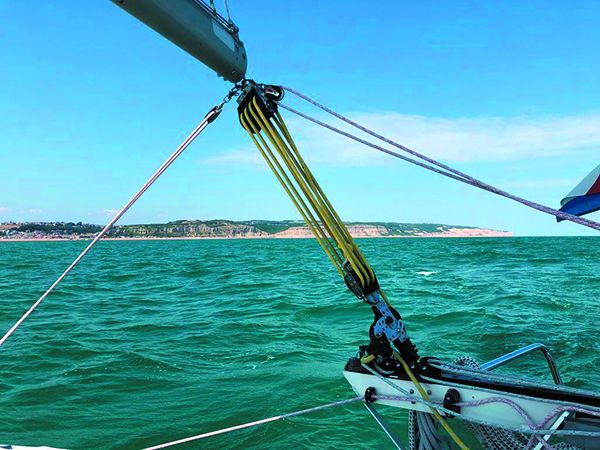
Multihulls
Extreme beam of multihulls affects how traveler and twin sheet systems are used. Travelers are typically full width and aft swept shrouds limit easing the boom to about 50 degrees from the centerline. As a result, there is little sheet out when the traveler is fully eased, even running. Likewise, twin-sheet systems have only a little sheet out to leeward. The downside is that widely spaced, twin-sheet tackle anchor points result in an obtuse
angle between the tackles and very high sheet loads when sailing upwind.
Less banging in sloppy light airs. With two sheets, the boom can be secured. But we very seldom had this problem, and we could always rectify it with a line to a stern cleat. On the other hand, in light moderate conditions, instead of the boom being able to move a bit and the sail flexing with the wind, the fixed boom made for some atrocious “booms” as the sail filled and backed when rolling. When it became a problem, there was no easy solution, as there would be with a traveler system. In the end, we decided this over-control of the boom was more minus than plus, but this probably varies with the motion of the boat and others may feel differently. Let’s call it a wash.
More complex sheeting. With a traveler and mainsheet system, the sheet primarily controls twist and the traveler controls the angle of attack. With two sheets they work together to form a triangle that controls the position of the boom. To windward, most adjustment require pulling two strings. When the leeward sheet is trimmed, the leach closes and the boom moves to leeward. If the windward sheet is trimmed, the leach closes and the boom moves to windward. Often both must be moved, in a sort of trial-and-error process. All of the same boom positions are possible, but it requires more thought and fiddling.
Less sheet purchase. It’s true that if the sheeting base is narrow, the tackles can be smaller, since they share the load when sailing to windward. On the other hand, with the wide base typical of a multihull (base 16 feet, boom height 5 feet), the angle is disadvantageous and the sheet load is not appreciably reduced. In both cases, there are now two tackles to be tensioned instead of one. Because our sheeting systems were different in each mode, we can only comment on the obvious math.
Load distribution. A traveler track is often a structural member of the boat. When the boat jibes, the stress is spread over a span of deck. With a twin sheet system, the loads, both vertical and transverse, are point loads, and either hard on the wind or during a jibe they can be massive. If converting from traveler to twin system, remember that managing the loads is more complicated than just adding a big backing plate; the cockpit coamings or cabin must be able to transfer potentially enormous shock loads safely to the hull. We’ve heard of cockpits crushed when a sailor removed a structurally necessary traveler bridge.
Conclusions
After weeks of playing with twin sheets, we went back to the traveler and single-sheet system. We enjoyed sailing with twin sheets and felt that a well engineered twin-sheet system will suit some boats and some sailors. We like twin sheets for cruising and even reefed down in heavy weather. Controlled jibing is nice. But racing or powered-up in a multihull or sport boat, rapid, simple adjustment is vital. In the end, we understand the overwhelming popularity of traveler-based systems on both cruising and race boats. Sailing is simpler.
































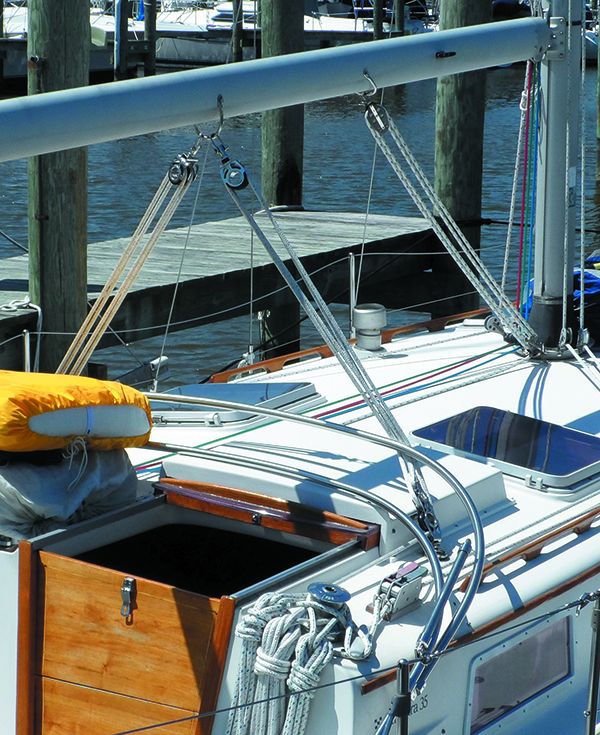




If you had these issues in paperback I would love to subscribe to your magazine . I want something I can refer back to . But you don’t , so I don’t .
You can easily download issues onto a computer. Beats the hell out of lugging 10 years of paper documents around. Takes up zero space and also adds zero weight – other than that of the computer.
Having said that, I have years of paper issues stored (most of which I have been able to download electronically) and would be happy to give them to you if you would pay for the expense to send them.
Practical Sailor is available in print. Check the subscription page.
Practical Sailor is available in print. Check the subscription page. Additionally, a subscription comes with full digital access to all back issues.
My F-9AXR trimaran was built with a twin sheet system, designed by Mike Leneman, who also supplied the wing mast & forestay. The boom is extended (approximately 18”) so that the sheets attach from the end of the boom down to the coaming near the aft end of the cockpit. It is a 12:1 continuous line with a shive on the boom joining both sides. We race more than cruise.
Observations after 7 years; we love the openness of the cockpit & only miss the traveller a little when racing upwind. When reaching, we just crack off a little & go. When running downwind with an assym spin, the main seems to work well cracked off a little more than a reach, but surprisingly much less than 45 degrees. We use the mainsail leach telltales to help us dial in trim.
Bottom Line; From my experience, the added complexity, weight & expense does not outweigh what would appear to be the small potential gains of a traveller system.
My wife and I have been living for 11 years aboard a 1997 Catana 44 with a twin sheet main. On our first crossing from Ft Lauderdale to Bimini in 2010 we noticed the single-point attachment of the mainsheet dead end and turning block was flexing the coaming under load. We pulled the deck rings from the coaming and used a hole saw to remove the fiberglass skin and discovered the coaming balsa core was saturated. We dug out all the wet core and filled the space out to about 2X the diameter of the deck ring bases with glass mat and epoxy, and enlarged the backing plates. We also added a second hard point for each sheet so that each dead end tied off on the original ring and the turning blocks on new ones, set three feet wider than the originals, these hard points also set on the coaming after replacing the balsa core as on the originals. This change effectively halved the load on the coaming rings, and substantially improved our ability to tweak the main with the wider spread of the mainsheet dead ends and turning blocks.
I’m surprised to read your technique for jibing with a traveler, and the comment about the traveler potentially “zipping across the cockpit”. I prefer to keep the traveler centered when sailing downwind.
I know that you Americans have your own brand of my language, but the verb ‘to better control’ can’t be found in any dictionary, yours or mine.
Your headline should read ‘Do twin sheets control the mainsheet better’.
PLEASE !
I have been using the traveler system for most of my life, 40+ years, and I just bought a catamaran with a Delta mainsheet system (Twin mainsheets). To me, the biggest factor is control of the leach and boom. My experience has been that I can get to a trim faster with the Traveler system but with a little more patients and fiddling around I can get to the same trim with the Delta.
The other point that I think is important to consider when choosing mainsheet systems is preventing accidental jibes. I think most readers know that one can use a preventer with the Traveler to avoid accidental jibes and this works well but it is still uncomfortable to say the least when it happens. The Delta system has a built in preventer out to a certain angle. If the boom is out past the leeward sheet deck attachment in the Delta system, you can still have problems though not as big as with the Traveler system.
To me, many of the other points addressed are about configuration and comfort. In my case, I still like the Traveler mainsheet over the Delta mainsheet because I am more oriented towards performance so I may convert my catamaran to a Traveler setup in the future. I’d be interested in experiences in converting from a Delta or Twin setup to a Traveler.
Thank you for the read.
Maybe I missed it, but one issue you don’t address is ease of access (or lack thereof) to both main sheet & traveler when you’re at the helm or tiller, i.e. right at the stern of the boat. This wasn’t a problem with my J24 as both traveler and main sheet are right at the helm/tiller, and so control of the main is extremely easy & convenient, and safe. But surely if the main is controlled from a traveler on the cabintop, this means that on most boats you have to leave the tiller or wheel and go forward to adjust the mainsheet and/or traveler?
If sailing single-handed, especially when entering/leaving port or a river or anchorage, having to leave the helm to go forward to the cabintop to adjust the mainsheet and/or traveler is surely a big inconvenience, maybe even dangerous? I would have thought that in this situation, a twin mainsheet leading to each quarter near the tiller or wheel where the helmsman can easily adjust the Main – would be invaluable – and far safer/more practical than trying to adjust the mainsheet and/or traveler on a cabintop.
So in short handed situations, especially in confined waters where maybe quite a bit of tacking/jibing is required, or spilling wind from the mainsail – surely this is where twin sheets led aft would really shine?
Hi. Good article. I’d like to describe what I have on my boat. It won’t be for everyone, because my trimaran is a center cockpit, ala Jim Brown, so I don’t have the problem of the lines draping over the cockpit when sheets are eased. My points of attachment are approx 7 ft apart. Boom height about 5 ft. I originally had a single line system with 3 blocks on the end of the boom, but that always sought its own level, like water, and would not stay where I wanted it. After looking at a Cantana at Raiatea with the twin, and separate, set up, I cut the sheet in two and run it through a fiddle on top and fiddle with becket on bottom, both sides. 3:1 purchase, I believe. The sheets come to a deck organizer on center, then through a double rope clutch and to a single, small, 2 speed winch, all of which, I can reach easily from the wheel. When gybing, I put one wrap of each sheet on the winch, clutches closed, and haul together. When the leeward one reaches vertical, and stops, I take the slack out of the windward one and I’m ready for gybing. Pulling both stops a ton of slack from laying around the deck and causing problems. I also had to reinforce under my deck attachments as the loads when the leeward one is vertical are pretty strong. I have a tackle vang, but when sheets are eased, I take a preventor out to a midships cleat and back to a winch, so then have a 3 point hold on the boom end. Having raced for many years, I really did not want a traveller with all the lines, winches and tackles. When going to weather, or close reach, it’s easy to put which ever sheet needs adjusting on the winch and give it a tweak. A couple of improvements that I’m thinking about when I get to return to the boat (Separate story: It’s in New Zealand and I’m stuck here in US, Covid, coming up 2 years now) is to have the 2 sheets different colors. There’s a lot of white line spread around sometimes. Also thinking about having only 2 feet, or so, of tackle and 4-5 ft of dyneema strops to the boom. This would save 20ft +/- of sheet length but might end up having flying blocks, if the gybe got out of hand. Overall, the system works really well for me and mainsail trim is where I want it.
You almost got it right. If you attach the preventers/sheets to the toe-rail just aft of the side chain plates and attach/use 2 boom bails to separate load on the boom, you will have control of the mainsail all the way out over the water, there are no dangerous lines in the cockpit, you cannot have a dangerous accidental jibe, all jibes are controlled safe events, control lines can be run along the side deck into the cockpit. You need to attach the preventer out on the toe rail. I’ve been using that system for decades and installed it on several boats successfully.